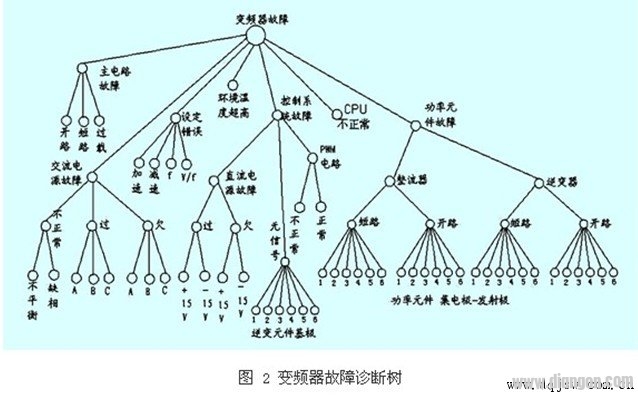Below is a detailed explanation of common diagnostic methods used in inverters. These techniques help technicians identify and resolve issues efficiently, ensuring the system operates correctly.
(1) Fault Tree Diagnosis: This method involves listing all possible faults that could occur in a system or device, then identifying their root causes—such as hardware failures, environmental factors, or human error. These are connected using logical relationships to create a fault tree, as shown in Figure 2. During diagnosis, the tree is analyzed from the bottom up until the exact cause is found. It’s especially useful when multiple faults exist, as it allows for a systematic approach. If a fault persists after checking one branch, it indicates another issue may be present, requiring further investigation until all faults are identified.
(2) Manual and Self-Diagnosis Combination: While an inverter's self-diagnostic system can detect the nature and location of a fault, it often struggles to determine the underlying cause. In such cases, manual inspection becomes necessary. By analyzing the information provided by the self-diagnosis, technicians can list potential issues and systematically check each suspect component. This process narrows down the problem, eventually leading to the identification of the exact cause and location.
(3) Contrast Diagnosis Method: This technique involves comparing different scenarios, such as disconnecting a section of the circuit or replacing a component. By observing whether the fault remains the same or disappears, you can determine if the issue is related to the specific part being tested. This method is widely used in inverters of the same type, making it a reliable tool for troubleshooting.
 During the inverter fault diagnosis process, it's essential to combine instrumentation with the inverter's built-in diagnostic system. Start by asking the user about the fault symptoms and checking the inverter’s indicators, including any changes in the external environment before and after the fault occurred—such as power fluctuations or load variations.
Here’s a step-by-step guide:
1. Analyze the cause of the failure based on the user's description.
2. Open the equipment to identify damaged components and assess the feasibility of repair.
3. Based on the location of the faulty component, review the circuit diagram to understand its function and identify related circuits that may have contributed to the failure.
4. Locate and prepare replacement parts.
5. After eliminating all possible causes, perform a power test under controlled conditions to ensure no further damage occurs.
6. Once the system works properly, proceed to conduct a full system test to confirm everything is functioning as expected.
By following these steps, technicians can effectively diagnose and resolve inverter issues, ensuring optimal performance and safety.
During the inverter fault diagnosis process, it's essential to combine instrumentation with the inverter's built-in diagnostic system. Start by asking the user about the fault symptoms and checking the inverter’s indicators, including any changes in the external environment before and after the fault occurred—such as power fluctuations or load variations.
Here’s a step-by-step guide:
1. Analyze the cause of the failure based on the user's description.
2. Open the equipment to identify damaged components and assess the feasibility of repair.
3. Based on the location of the faulty component, review the circuit diagram to understand its function and identify related circuits that may have contributed to the failure.
4. Locate and prepare replacement parts.
5. After eliminating all possible causes, perform a power test under controlled conditions to ensure no further damage occurs.
6. Once the system works properly, proceed to conduct a full system test to confirm everything is functioning as expected.
By following these steps, technicians can effectively diagnose and resolve inverter issues, ensuring optimal performance and safety.
Usb-C To Lightning Cables,Pd Charger Cable,Fireproof Braided Charger Cable,Pd Fast Charger Cable For Apple Devices
Dongguan Pinji Electronic Technology Limited , https://www.iquaxusb4cable.com